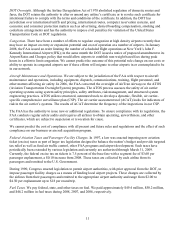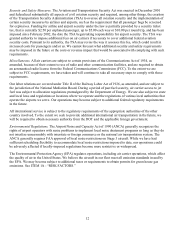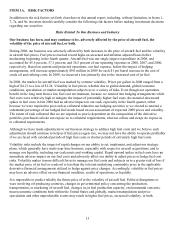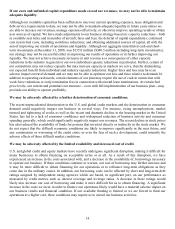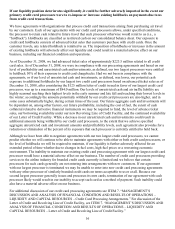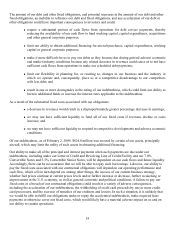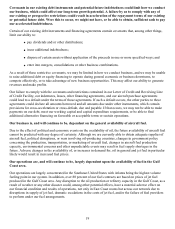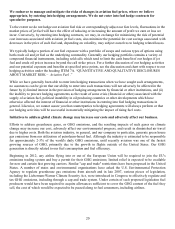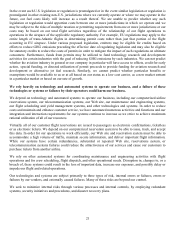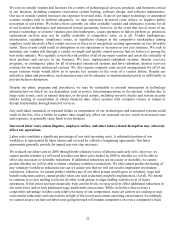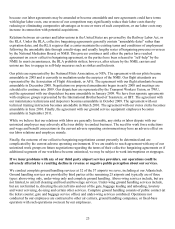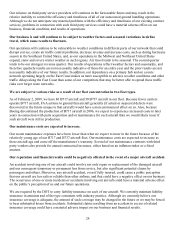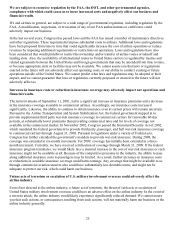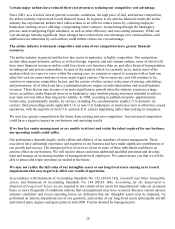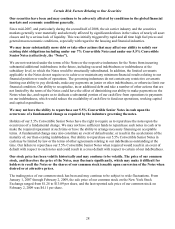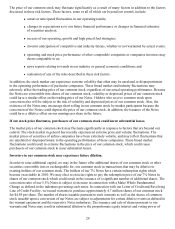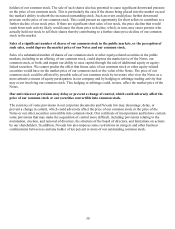Airtran 2008 Annual Report Download - page 28
Download and view the complete annual report
Please find page 28 of the 2008 Airtran annual report below. You can navigate through the pages in the report by either clicking on the pages listed below, or by using the keyword search tool below to find specific information within the annual report.We endeavor to manage and mitigate the risks of changes in aviation fuel prices, where we believe
appropriate, by entering into hedging arrangements. We do not enter into fuel hedge contracts for
speculative purposes.
To the extent we do not hedge our aviation fuel risk or correspondingly adjust our fare levels, fluctuations in the
market prices of jet fuel will have the effect of reducing or increasing the amount of profit we earn or loss we
incur. Conversely, by entering into hedging contracts, we may, in exchange for minimizing the risk of potential
cost increases associated with aviation jet fuel costs, also minimize the potential for cost savings associated with
decreases in the price of such fuel and, depending on volatility, may subject ourselves to hedging related losses.
We typically hedge a portion of our fuel exposure with a portfolio of swaps and various types of options using
both crude oil and jet fuel as the underlying commodity. Generally our hedging portfolio contains a variety of
compound financial instruments, including sold calls which tend to limit the cash benefit of our hedges if jet
fuel and crude oil prices increase beyond the call strike prices. For a further discussion of our hedging activities
and our potential exposure and benefits at specified price points, see the discussion and chart with respect to our
hedging activities under the heading ITEM 7A. “QUANTITATIVE AND QUALITATIVE DISCLOSURES
ABOUT MARKET RISK – Aviation Fuel .”
While we have generally been able to enter into hedging transactions when we have sought such arrangements,
no assurances can be given that our ability to enter into such transactions will not adversely be affected in the
future by (i) limited interest in the provision of hedging arrangements by financial or other institutions, and (ii)
the inability to procure hedging agreements as the result of some crisis (financial or other) associated with the
supply of aviation fuel, political instability in oil producing countries or other developments which have
otherwise affected the interest of financial or other institutions in entering into fuel hedging transactions in
general. Likewise, we cannot assure you that counterparties to hedging agreements will always perform or that
our hedging activities will be successful in materially mitigating the impact of rising fuel costs.
Initiatives to address global climate change may increase our costs and adversely affect our business.
Efforts to address greenhouse gases, or GHG emissions, and the resulting impacts of such gases on climate
change may increase our cost, adversely affect our environmental progress, and result in diminished air travel
due to higher costs. Both the aviation industry, in general, and our company in particular, generate green house
gas emissions from our utilization of petroleum-based fuel. Although the industry is estimated to be responsible
for approximately 2-3% of the world's daily GHG emissions, until recently aviation was one of the fastest
growing sources of GHG, primarily due to the growth in flights outside of the United States. Our GHG
generation is directly related to our fuel consumption and fuel efficiency.
Beginning in 2012, any airline flying into or out of the European Union will be required to join the EU's
emissions trading system and buy a permit for their GHG emissions; limited relief is expected to be available
for new and certain fast growing carriers. Similar "cap and trade" restrictions have been proposed in the United
States. A number of states and environmental organizations have asked the U.S. Environmental Protection
Agency to regulate greenhouse gas emissions from aircraft and in late 2007, various pieces of legislation,
including the Lieberman-Warner Climate Security Act, were introduced in Congress to effectively regulate and
tax GHG emissions, including through a cap and trade system. Under certain of such proposed legislation fuel
producers would have been required to acquire allowances sufficient to cover the GHG content of the fuel they
sell, the cost of which would be expected to be passed along to fuel consumers, including airlines.
20



